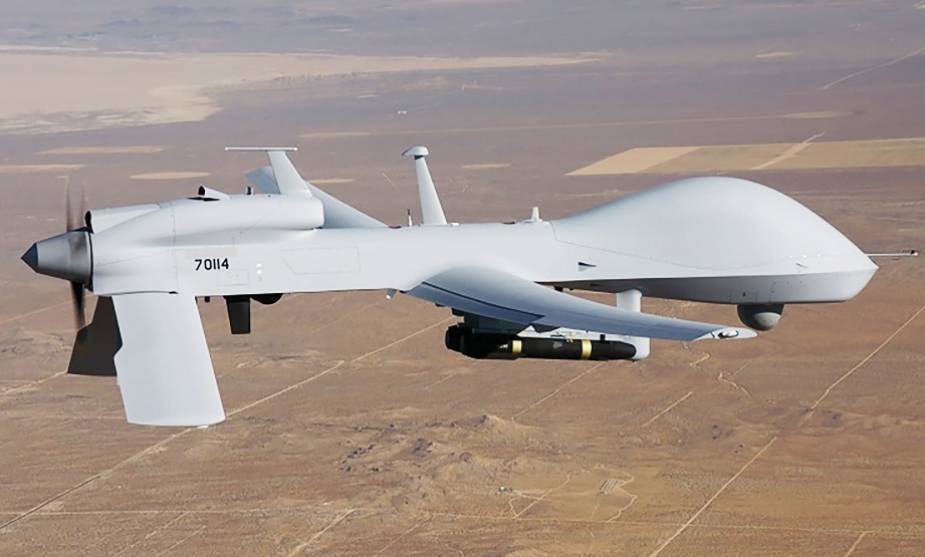Russia needs common counterdrone concept – Part 2
There is a search for new methods to fight air targets triggered by a rapid development of drones, which pose a major danger to the warring parties and numerous economic, infrastructure objects and mass events in peacetime, Colonel PhD Military Science V. Tikshaev and Retired Lieutenant-General PhD Military Science V. Barvinenko write in the Military Thought magazine.
Follow Army Recognition on Google News at this link

Current large UAS platforms like this General Atomics MQ-1C Gray Eagle provide important capabilities but need a runway to take off. These systems also have lower airspeeds and depend on data links and GPS signals. Future systems will need to be more independent to operate in a complex battlespace (Picture source: courtesy of AMRDEC)
Further drone development will change the role of the vehicles in modern armed conflicts. They will develop from support means into a major component of hostilities. The growing strength of drones in potential Russian adversaries and the development of long-range precision weapons provide a possibility for them to engage only unmanned vehicles against Russia. Manned aviation will be likely used to fire dummy targets, cruise and hypersonic missiles from outside the operational area of fighter jets, antiaircraft missiles, and radars. It will change the general methods of air strikes and offensive air operations and campaigns.
In air operations, massive missile strikes will be replaced by strikes of hypersonic missiles, non-strategic ballistic missiles, cruise missiles and drones. The first echelon of the strikes against air defense is likely to engage numerous dummy targets and swarms of mini- and macro-drones instead of airplanes. After the first surprise (preemptive) strike, massive missile strikes are likely to be replaced by single, group and concentrated strikes with ballistic, cruise missiles and drones. They will be delivered, as adversary targets are exposed by netcentric actions.
Drones are likely to constantly stay in the hostile airspace for reconnaissance and strikes. Major losses of drones will not restrict planning and delivery of strikes at adversary targets.
The growing number of air weapons (due to unmanned vehicles), which potential Russian adversaries can engage against it, the character of their actions and the possibility to engage drones in peacetime demand revising numerous existing provisions for the composition of forces, organization of air defense and groups of troops both in war and peacetime. The reasons for the revision are as follows: mini- and macro-drones will comprise most of the air weapons, the cross section will decrease, altitudes will descend and speed accelerate, traditional reconnaissance and strike weapons (radars, long- and medium-range missiles, fighter jets) are incapable of destroying and detecting them.
Besides, the number of the complexes and systems is set for the main mission to defend specific objects and groups of troops against traditional air weapons and is limited by economic factors. Although some antiaircraft weapons of the ground forces (Tor-M1/M2/M2U, Osa-AKM, Tunguska, Sosna, Strela-10M3, Verba manpad, Shilka, Derivatsia-PVO) and antiaircraft weapons of warships can down mini- and micro-drones, they are engaged in combat formations of their units and warships and can be used for fragmented counterdrone missions in the limits of their responsibility zone.
The use of a large number of dummy targets and swarms of mini and micro drones to break through the air defense will trigger fire and a rapid consumption of missiles, which are more expensive than drones. It will create conditions for further unimpeded fire by powerful precision weapons, guided swarms of drones that simultaneously strike at the air defense system from various directions and are difficult to destroy. A large number of attack drones demands to provide defense of a bigger number of objects as hostilities begin, as well as of government, industrial, fuel and energy facilities, environmentally hazardous objects, infrastructure and mass events in peacetime.
The mentioned factors and the inability of traditional air defense to detect and destroy mini and micro drones called for the design of counterdrone methods by the existing air defense and requirements for their upgrade, as well as revise the composition of forces in the general air defense system of the country.
© Copyright 2021 TASS / Army Recognition Group SPRL . All rights reserved. This material may not be published, broadcast, rewritten or redistributed.


























